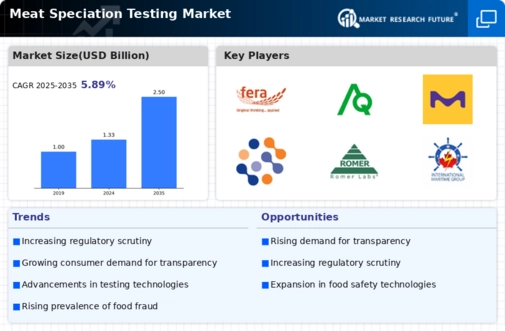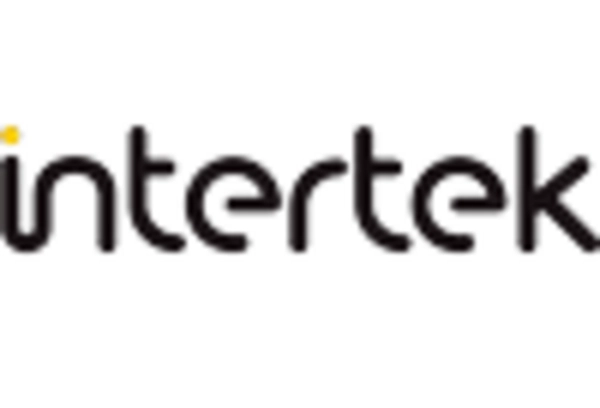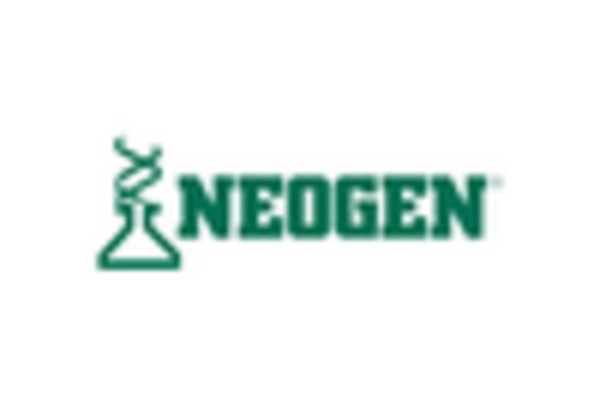Regulatory Compliance and Food Safety
Regulatory compliance is a critical driver for the Meat Speciation Testing Market, as governments and food safety authorities impose stringent regulations to ensure the integrity of meat products. The implementation of regulations such as the European Union's Food Information to Consumers Regulation mandates accurate labeling of meat products, which necessitates reliable testing methods. As a result, the demand for meat speciation testing is expected to rise, with the market projected to reach a valuation of USD 500 million by 2026. Compliance with these regulations not only protects consumers but also enhances the reputation of food brands. Companies that invest in meat speciation testing are likely to gain a competitive edge, as they can assure customers of the authenticity and safety of their products. This regulatory landscape is shaping the future of the Meat Speciation Testing Market.
Growth of the Meat Processing Industry
The Meat Speciation Testing Market is poised for growth, driven by the expansion of the meat processing industry. As meat processing facilities scale up operations to meet rising consumer demand, the need for effective testing methods becomes increasingly critical. The meat processing sector is projected to grow at a CAGR of 5% over the next few years, which will likely lead to a corresponding increase in the demand for meat speciation testing. This growth is fueled by the need to ensure product quality and safety, as well as to comply with regulatory standards. Consequently, meat processors are investing in advanced testing technologies to mitigate risks associated with species mislabeling. This trend underscores the importance of meat speciation testing in maintaining the integrity of the meat supply chain and supports the overall growth of the Meat Speciation Testing Market.
Emerging Markets and Global Trade Dynamics
Emerging markets are becoming increasingly influential in the Meat Speciation Testing Market, as globalization facilitates the trade of meat products across borders. Countries with developing economies are witnessing a rise in meat consumption, which in turn drives the need for reliable testing methods to ensure compliance with international standards. The market for meat speciation testing is expected to expand in these regions, as local producers seek to access global markets. Additionally, trade agreements and partnerships are likely to enhance the demand for testing services, as they often include provisions for food safety and quality assurance. This dynamic presents a significant opportunity for growth within the Meat Speciation Testing Market, as stakeholders adapt to the evolving landscape of global trade.
Technological Advancements in Testing Methods
The Meat Speciation Testing Market is experiencing a surge in technological advancements that enhance the accuracy and efficiency of testing methods. Innovations such as polymerase chain reaction (PCR) and next-generation sequencing (NGS) are becoming increasingly prevalent. These technologies allow for rapid identification of meat species, which is crucial for ensuring food safety and quality. The market for meat speciation testing is projected to grow at a compound annual growth rate (CAGR) of approximately 7% over the next five years, driven by these advancements. As testing methods become more sophisticated, they not only improve detection rates but also reduce the time required for analysis, thereby meeting the demands of both regulatory bodies and consumers. This trend indicates a robust future for the Meat Speciation Testing Market.
Rising Consumer Awareness and Demand for Transparency
Consumer awareness regarding food safety and quality is a significant driver for the Meat Speciation Testing Market. As consumers become more informed about the origins of their food, there is an increasing demand for transparency in meat labeling. This trend is reflected in the growing preference for products that are certified and tested for authenticity. Market Research Future indicates that approximately 60% of consumers are willing to pay a premium for meat products that are verified through testing. This shift in consumer behavior is prompting food manufacturers to adopt meat speciation testing as a standard practice. The Meat Speciation Testing Market is thus positioned to benefit from this heightened demand for transparency, as companies seek to build trust with their customers through reliable testing methods.


















Leave a Comment